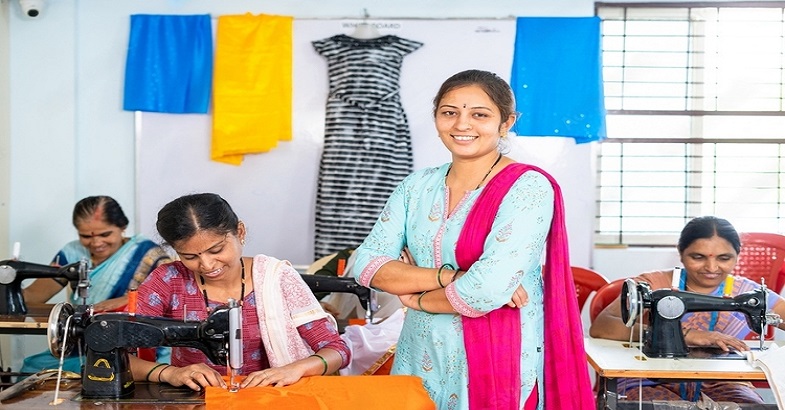
“If you educate a man, you educate an individual, but if you educate a woman, you educate a family (nation)” – Dr. James Emmanuel Kwegyir-Aggrey
This principle may be applied to financial empowerment and growth of women. Once women are empowered, the chances of future generations being healthy, educated, and financially secure often multiply.
This aspect was exemplified by my interaction with a woman who underwent skill training. After facing a multitude of challenges, including marital rape and domestic abuse, she came across a skill development training programme. This mother of two, through her grit, underwent training and later became an entrepreneur. She is also one of the few female autorickshaw drivers in her city. Her perseverance saw her navigate through a dim life to one where she could look after herself and her family. Her experiences strengthened her determination to ensure her daughter is educated and skilled to be employed, can sustain herself and is independent in making decisions. The role of women as mothers and homemakers can initiate and perpetuate a cycle of learning and education within their families. This role subsumes more power if they are educated and empowered.
Financial and social empowerment has an impact on the agency one can exercise within one’s family. Hence, a woman who is empowered is equipped to have a say in matters governing her life, such as marriage, employment, and pregnancy, than a woman who is not empowered.
Women and Employment
A major source of empowerment emanates from an individual’s working status. This has hitherto been the basis of family heads, who end up taking decisions on behalf of their family members. In the Indian context, and worldwide as well, the authority that male earning members yield over the non-working and earning members, especially women is well known. The nurturing and childbearing roles of women often relegated them to household confines, where education and thus employment became a far-sighted dream for many. In the absence of formal education, employability becomes closely tied to vocational skills. Recognising this, globally as well as in India several initiatives and schemes have been undertaken to provide skill training to the youth to ensure they are equipped with employable skills. Several schemes and initiatives have been initiated with a special focus on increasing women participation. Over the years, India has witnessed a rising trend of women participation in wage labor employment – it has risen from 23.3% in 2017-18 to 37% in 2022-23.
Given the social, economic, and cultural constraints that limit women’s participation, women have been on the fringes of receiving the intended benefits and have been sidelined by their non-participation or dropping out of interventions owing to several factors. The dropout rates of women at every stage— enrollment, training, certification, placements, and working for more than three months, is always higher than that of men. Assigning a percentage to this may be challenging presently, as different schemes have different criterion and data points.
Skill Development and Sustainable Livelihoods for Women
To ensure that the youth of India are employable and have adequate skills to set up their initiatives, Skill Development in India has been an important agenda since 1956. Very recently, in 2015, the Skill India Mission was launched to consolidate ongoing efforts and usher in a new, more concerted direction towards skilling the country’s youth.
Given that skill training initiatives in recent years have multiplied, the participation of women in the labour force is at 37% in 2022-23, an increase from 32.8% in the preceding year, while for men, it is 78.5% in 2022-23. The reasons for lower participation of women are rooted in socio-cultural conditioning and context. There is a much more complex path to manoeuvre to ensure this percentage rises.
Steps to Increase Women’s Participation
To ensure that more women are brought within the Skill India Mission’s ambit, considering the following may potentially be helpful.
Firstly, the schemes may look at incentivising participation of women by offering incentives (financial and/or non-financial) to women joining training programmes and eventually taking up employment opportunities. This may act as a motivating factor, not just for them but also for their families. Another aspect could be to incentivise programmes for training partners by increasing funding for joining and retention of trained women at workplaces, not just on their training and certification. This may help tilt the focus from providing certificate and jobs to women to ensuring they sustain themselves in jobs. This will also imply overhauling the entire training process through a renewed focus on counselling, soft-skills training, and post-placement support to women. Thirdly, providing mentorship and counselling support to women and their families, including spouses, may go a long way in comforting both. Setting expectations of potential employment opportunities, salaries, and location will help them decide to undertake training. In cases of migration, providing a support centre that houses counsellors who will help women search for accommodation, seek travel support, and be readily available to resolve their concerns will increase confidence in both the women and their families. Providing creche and day-care facilities will also help more women partake in skill training as they will not be worried about leaving their children behind. Several women who participate in programs often drop out during training are usually young mothers of infants. Ensuring every district has an aspirational skill centre set up with a creche facility will help them give their undivided attention to the training. Already existing centres may be uplifted infrastructurally to provide this service. Lastly, onboarding employers and institutionalising their role to ensure women’s safety at the workplace, appointing counsellors/buddies to help navigate work life will help sustain women in jobs for longer.
These measures will go a long way in ensuring that women not only enter the formal workforce but are supported enough to ensure they sustain in it. Enabling women to be financially independent will go a long way, empowering their families as well.

Author’s bio: With a Master’s degree in Sociology, Tanya is a development sector practitioner with over 12 years of experience. She specialises in the implementation and operationalisation of policies with a special focus on skill development and livelihoods of the Indian youth. She is currently with Generation India Foundation, focusing on advancing skill development and livelihood policies to contribute significantly towards the socio-economic upliftment of the disadvantaged sections of India. Previously, she has worked with the Ministry of Rural Development, National Skill Development Corporation and Tata STRIVE. She is a participant of the Advanced Management Programme in Public Policy (AMPPP) at Bharti Institute of Public Policy, Indian School of Business.
DISCLAIMER : The views expressed in this blog/article are author’s personal.

